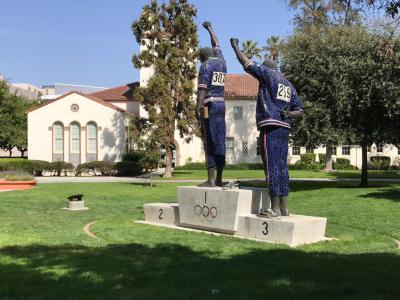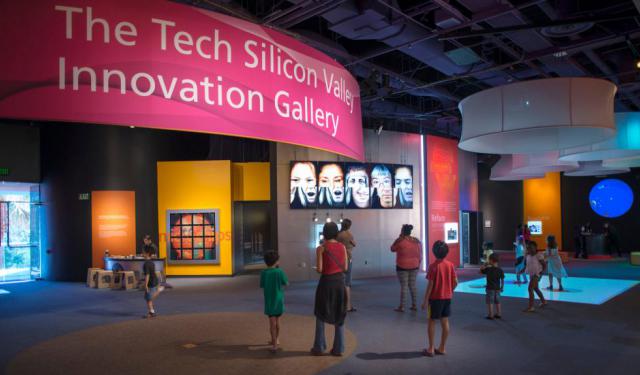Olympic Black Power Statue, San Jose
Artist: Rigo 23
Year: 2005
Commissioned By: San José State University
Designed by artist, Rigo 23, this larger-than lifesize fiberglass and mosaic monument, centrally placed on San José State University’s Tower Lawn, depicts the heroic and symbolic action of two African-American athletes and San José State University alumni, Tommie Smith and John Carlos, who, during the medal ceremony for the 200-meter running final in the Olympic Stadium in Mexico City on October 16, 1968, performed the Black power salute, raising their fists in silent protest. Smith, in the first place spot and Carlos, in third, planned and executed the gesture to draw attention to injustice and inequality faced by Black Americans but were greeted with boos and threats from the audience. Rendering the iconic moment through details such as the gloved hands and shoeless feet of the two athletes, Rigo 23 shows that the gesture was not accidental but planned for maximal symbolic effect.
Reenacted at SJSU in monumental form, Smith and Carlos’s protest and call towards justice is uplifted and celebrated. The second place podium spot, left empty, invites spectators to imagine themselves alongside the two icons and to follow their example in pledging to take responsibility and action towards eradicating anti-Black racism and bias.
Clad in the colors of the nation that denied African American civil rights, Smith and Carlos took a stand to draw global attention to inequality in the United States. Portrayed larger than life, their action on the medal podium echoes the chants of “Black Lives Matter,” the continuation of work to achieve dignity, equality, and justice for all citizens of this country. The statue poses a paradox for viewers. Demonstrating the harnessing of education, self-determination, and accepting of consequences to challenge the inequities of the status quo, while located on a campus of higher education at a time when those seeking an education and independence are doing so at significant financial cost to themselves, their families, and their futures.
The work for dignity, equity, and justice has and continues to take on obstacles that are meant to slow and discourage progress. Movements for equity find support among the unsung who go without recognition. The absence of silver medal winner Peter Norman of Australia, who supported Smith and Carlos’ protest, is a reminder that all people have a responsibility to humanity to stand up against intolerance and bigotry.
As you walk to your next stop, you’ll notice two notable arts and cultural institutions, the San José Museum of Art and the Cathedral Basilica of San José. Fine arts housed in cultural institutions can create unintentional entry barriers where public art does not. Sculptures placed on sidewalks and murals found on building walls are freely critiqued by anyone at any time which in itself is a means of resistance to ticketed and invited art viewing experiences.
For the next public art, look for the restaurant Mezcal - and peek around the side of their building for a fantastic view.
Year: 2005
Commissioned By: San José State University
Designed by artist, Rigo 23, this larger-than lifesize fiberglass and mosaic monument, centrally placed on San José State University’s Tower Lawn, depicts the heroic and symbolic action of two African-American athletes and San José State University alumni, Tommie Smith and John Carlos, who, during the medal ceremony for the 200-meter running final in the Olympic Stadium in Mexico City on October 16, 1968, performed the Black power salute, raising their fists in silent protest. Smith, in the first place spot and Carlos, in third, planned and executed the gesture to draw attention to injustice and inequality faced by Black Americans but were greeted with boos and threats from the audience. Rendering the iconic moment through details such as the gloved hands and shoeless feet of the two athletes, Rigo 23 shows that the gesture was not accidental but planned for maximal symbolic effect.
Reenacted at SJSU in monumental form, Smith and Carlos’s protest and call towards justice is uplifted and celebrated. The second place podium spot, left empty, invites spectators to imagine themselves alongside the two icons and to follow their example in pledging to take responsibility and action towards eradicating anti-Black racism and bias.
Clad in the colors of the nation that denied African American civil rights, Smith and Carlos took a stand to draw global attention to inequality in the United States. Portrayed larger than life, their action on the medal podium echoes the chants of “Black Lives Matter,” the continuation of work to achieve dignity, equality, and justice for all citizens of this country. The statue poses a paradox for viewers. Demonstrating the harnessing of education, self-determination, and accepting of consequences to challenge the inequities of the status quo, while located on a campus of higher education at a time when those seeking an education and independence are doing so at significant financial cost to themselves, their families, and their futures.
The work for dignity, equity, and justice has and continues to take on obstacles that are meant to slow and discourage progress. Movements for equity find support among the unsung who go without recognition. The absence of silver medal winner Peter Norman of Australia, who supported Smith and Carlos’ protest, is a reminder that all people have a responsibility to humanity to stand up against intolerance and bigotry.
As you walk to your next stop, you’ll notice two notable arts and cultural institutions, the San José Museum of Art and the Cathedral Basilica of San José. Fine arts housed in cultural institutions can create unintentional entry barriers where public art does not. Sculptures placed on sidewalks and murals found on building walls are freely critiqued by anyone at any time which in itself is a means of resistance to ticketed and invited art viewing experiences.
For the next public art, look for the restaurant Mezcal - and peek around the side of their building for a fantastic view.
Want to visit this sight? Check out these Self-Guided Walking Tours in San Jose. Alternatively, you can download the mobile app "GPSmyCity: Walks in 1K+ Cities" from Apple App Store or Google Play Store. The app turns your mobile device to a personal tour guide and it works offline, so no data plan is needed when traveling abroad.
Olympic Black Power Statue on Map
Sight Name: Olympic Black Power Statue
Sight Location: San Jose, USA (See walking tours in San Jose)
Sight Type: Statue/Public Art
Guide(s) Containing This Sight:
Sight Location: San Jose, USA (See walking tours in San Jose)
Sight Type: Statue/Public Art
Guide(s) Containing This Sight:
Walking Tours in San Jose, California
Create Your Own Walk in San Jose
Creating your own self-guided walk in San Jose is easy and fun. Choose the city attractions that you want to see and a walk route map will be created just for you. You can even set your hotel as the start point of the walk.
San Jose Museums Tour
The capital of Silicon Valley, San Jose is full of discovery and innovation. Also, steeped in history – established since 1777 – the city has born witness to numerous chapters of American past. When it comes to culture, education and recreation, the local museums are a perfect destination for solo adventurers new to the area.
Here, among other things, you can:
- get hands-on with... view more
Tour Duration: 2 Hour(s)
Travel Distance: 3.9 Km or 2.4 Miles
Here, among other things, you can:
- get hands-on with... view more
Tour Duration: 2 Hour(s)
Travel Distance: 3.9 Km or 2.4 Miles
San Jose Public Art Walking Tour
This walking tour, “Public Art as Resistance in San José,” highlights the history of resistance and public art in downtown San José and begins on the urban university campus, San José State University. Starting from the first two works of art on campus, you’ll find that these 12 works of public art are among many in this area. However, this particular walking tour considers how San... view more
Tour Duration: 3 Hour(s)
Travel Distance: 6.0 Km or 3.7 Miles
Tour Duration: 3 Hour(s)
Travel Distance: 6.0 Km or 3.7 Miles
San Jose Downtown Walking Tour
San Jose is California's third-largest city and the second-largest city in Northern California. From 1849 to 1851, San Jose served as the state's first capital, which is still a local source of pride. The city has formally incorporated in 1850 and has been a center of innovation from the late 19th century, starting with agriculture and food processing.
During World War II, several... view more
Tour Duration: 1 Hour(s)
Travel Distance: 1.9 Km or 1.2 Miles
During World War II, several... view more
Tour Duration: 1 Hour(s)
Travel Distance: 1.9 Km or 1.2 Miles






